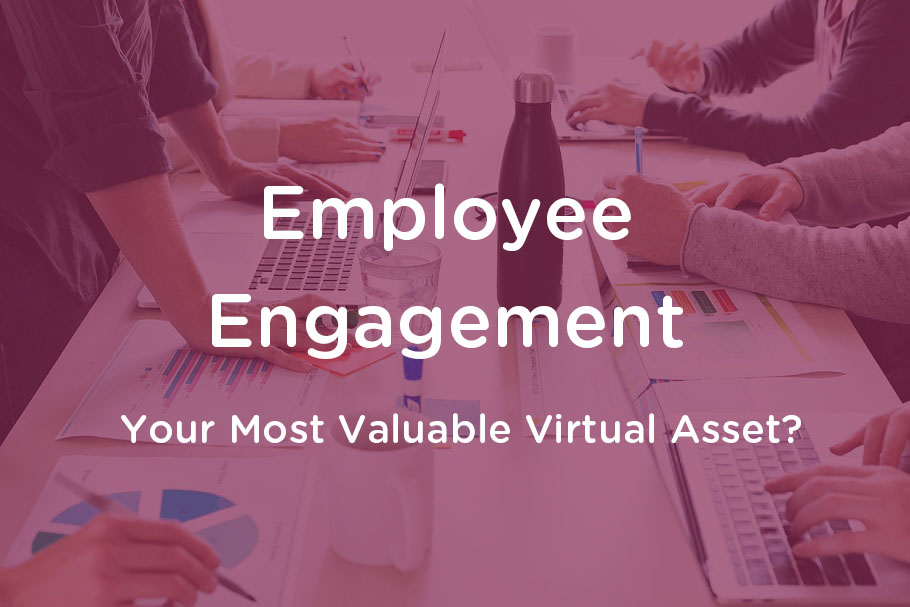Employee Engagement As Your Most Valuable Virtual Asset?
Employee engagement with social issues has become a must-have requirement to most profit-purpose partnerships because it’s just good for business. From profitability to greater consumer satisfaction, the measured impact that engaged employees can have on a business bottom line is undeniable.
Direct Impact on Profits
- Studies show that businesses with the highest levels of employee engagement are 22% more profitable than those with low levels of engagement (Gallup).
- Organizations with higher than average employee engagement have been known to exceed the financial performance of their peers by 73% (University of Pennsylvania’s Wharton School).
Higher Productivity and Retention
- An employee who feels engaged and inspired is 125% more productive than the satisfied staffer. (Bain & Company)
- Employees who find passion and purpose at work are more than three times as likely to stay with their organizations as those who don’t. (New York Times)
Greater Customer Experience
- In one study, companies with engaged employees had 89% greater customer satisfaction and 50% higher customer loyalty than their disengaged counterparts. (Hay Group)
- Customers are willing to pay 16% more for convenience and friendliness. (PwC)
Companies have leveraged social causes and their nonprofit partnerships to inspire, engage and contribute to heightened employee engagement and satisfaction for decades. But, as the world shuts down, becomes more remote, and digitally inclined, how can companies and causes still accomplish the same level of engagement that is critical to profitability?
When looking at the role of profit-purpose partnerships within our society, we often recommend three ways to develop employee engagement opportunities at your nonprofit organization or company to drive engagement and impact on the community – regardless of the mission you serve.
- Team Building
Companies have created teams that fundraise for a cause for many years now, and most are facilitated through traditional peer-to-peer fundraising events (e.g. the American Heart Association’s Heart Walk or the American Cancer Society’s Making Strides Against Breast Cancer). However, if your nonprofit doesn’t have a peer fundraising program, or your program is now forced into the virtual world, we must create opportunities that facilitate employee team building that is also seamless, turnkey and easy for individuals to engage regardless of the location. Virtual “team challenges” have become extremely popular and hit the mark for employees, causes and employers.
Donor Drive has a new fitness challenge app that builds teamwork
Benevity gamifies small actions for mission engagement
Charity Miles enables charities to engage individuals from anywhere
- Talent
Skills-based volunteering is a rising employee engagement trend that can be extremely satisfying for the employee and highly impactful for the community. Skills-Based Volunteering (SBV) is the practice of lending one’s specific professional expertise to community organizations in a way that helps them affect social change. the Taproot Foundation reports that 68% of nonprofit professionals do not have the resources they need to do their work. Whether it’s John in Accounting that can help an organization with an annual audit, or Samantha on the Creative Team that can lend her expertise to communication materials, SBV is a great way for nonprofits to expand their bandwidth and knowledge-base, while also engaging specialized employees/executives of their corporate partners. Points of Light suggests that skills-based volunteering comes in all shapes and sizes, including:
- Individual volunteers, corporate paid/unpaid volunteers, loaned executives, interns
- Projects completed in a day; short, medium or long-term projects
- Activities performed during working hours or on individual time
- Planned in advance or spontaneous projects such as disaster response
- Application of all types of skills and talents from professional experience to hobbies
- Content from nonprofit infrastructure efficiency effort to direct “in the field” projects
- Local impact to national and international
The good news for nonprofits looking to create an SBV program is that many corporations already have the existing infrastructure to support it. One great example is IBM.
IBM’s Service Corps gives employees the chance to spend several weeks helping others tackle complex problems. Teams of 12 to 15 IBMers partner with government, business, and civic leaders to address high–priority issues such as education, health, disaster preparedness, and economic development. Since it began in 2008, IBM Service Corps has sent more than 4,000 employees to more than 1,400 projects in over 40 nations.
If you are a nonprofit, work with your internal teams to identify greatest need for support, then package 3 – 5 opportunities for corporate executives with specialized skills to get involved.
- Time
Some might say that pro bono volunteerism is a cornerstone of communities around the globe. Most of us have (or could find) a few hours within our daily lives to volunteer our time to support our community. Some organizations have more natural pro bono volunteerism opportunities (i.e. Pack meal kits or build homes), while others typically struggle to identify pro bono volunteer mission-fit. With the proliferation of virtual volunteerism, many organizations and resources have developed the infrastructure and creative engagement options for any mission or employee looking to get involved with their community. Check out what is new from longstanding virtual volunteer programs like:
All three of these options may be right fit for your organization or company, while it also may make more sense to focus on just one area. What’s exciting is that our new world of virtual connection has unveiled new technologies that make employee engagement possible and perhaps even more impactful. Regardless of the path you choose, please remember to always measure the efficacy of employee engagement. Doing so pre- and post- engagement will ensure your partnerships not only continue, but deepen the connection between employee and cause for years to come.
To learn more about how employee engagement opportunities should be your newest valuable asset, join us for an upcoming webinar featuring Donor Drive and Blessings in a Backpack.









Leave a Comments